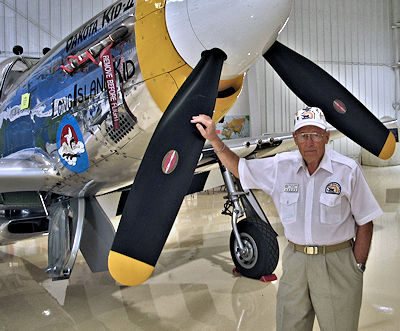O. B. Carter Army Air Corps
Flying the P38 at Home
Flying the P51 & P47 in Burma

Flying P38s at Home
The P-38 was very easy to operate and a real joy to fly as long as everything went normally as planned. However, in modern computer terms, it was not always a user friendly airplane and had a few bad habits as most high performance airplanes do.
First among them was the so-called compressibility phenomenon wherein at high vertical dive speeds, the air would begin to pack up ahead of the wing and the elevator control would become useless and so rigid that you couldn't move it. It happened to me in July 1942. I was not unduly alarmed at first because we had been well-briefed on the phenomenon and were told the correct procedure was to reduce power and use elevator trim control in order to bring the nose up, slow up, and regain elevator control. I did this but when I had rolled the elevator trim to its full nose up travel against the stops and nothing happened, I realized that I was in deep, serious, probably fatal trouble. It was discovered later that the elevator control rod linkage had broken completely where it passed through a bulkhead in the horizontal stabilizer!
Now, the aeronautical engineers tell us that it is aerodynamically impossible for a propeller-driven airplane to go supersonic or even into the trans-sonic barrier. No doubt they are correct and I make no claims. But they also say that aerodynamically, it is impossible for a bumblebee to fly. I don't argue the point. All I know is that on that memorable day in July 1942, for a few seconds, probably not over 2 or 3, it got awfully quiet and very, very smooth (which I am told is typical of supersonic flight) just before all hell broke loose and that "E" model P-38 started to come apart.
First the canopy left and almost instantly the side windows imploded inward. We know that because after landing there were still large jagged chunks of Plexiglas from the side windows laying on the cockpit floor and on my lap. Then, not necessarily in order but very rapidly, the high speed fairings around the wing roots (just outside of the cockpit) peeled off, the wheel well doors tore off, the cowling around the inside coolant radiator on the left boom tore off and took out with it much of the left vertical stabilizer and rudder. This caused the tail booms to be slightly warped to one side. Finally most of the glass covering the instruments on the cockpit panel was broken but I still had a good air speed indicator and altimeter.
All this destruction undoubtedly saved my life because the resulting drag as I came into heavier air at lower altitude, slowed up the airplane enough for me to regain elevator control and finally get it out straight and level at about 1000 feet MSL over that big hill in La Jolla, California, which I believe is about 800 feet above sea level. I had started at about 32,000 feet. The airplane was so un-airworthy that it took full power on both engines to get it back to the North Island Naval Air Station in San Diego. I was able to get the gear down OK but not the flaps so the landing (cross traffic) was pretty fast.
As a result of this experience a fix was developed to correct the problem. It consisted of an inverted V-shaped dive brake device located under the wing at about the mean chord line, which would pop out about 6 or 8 inches when activated by a red emergency panic switch on the wheel.

This experience was the first of five incidents that occurred to me in the next 6 months which proved conclusively the rugged construction, durability and dependability of the P-38. Without going into boring detail these incidents consisted of (2) an engine fire at high altitude, (3) a midair collision, (4) flying through very high voltage power lines, which knocked most of southern California south of Escondido out of power just 2 days before Christmas 1942, and finally (5) landing a P-38, single engine on a county road, with full drop tanks, on New Years Day 1943. This was caused by total failure of the left engine, total loss of oil pressure on the right engine, and an extreme desire to put that bird on the ground at the nearest stretch of hard surface ASAP before that running engine seized up!!!
Flying P51s & P47s in Burma
In Burma [with The First Air Commandos] we developed a system of low altitude vertical dive bombing with the P-51 which gave almost pinpoint accuracy. However since we were using both 500 and 1000 lb. bombs on racks designed for 375 lb. maximum, we sometimes had difficulty with bombs hanging up on release. It didn't take long to discover that a quick shake of the stick sideways, simultaneous with the bomb release, would usually insure bomb separation from the airplane.
Since we were mostly involved in close air-ground support and interdiction missions, we rarely saw the Japanese in the air. I only had air-to-air combat on five of my 82 missions, but found the P-51 to be very effective against Japanese fighters, using the normal hit-and-run tactics. In this manner, I was able to get two confirmed Japanese fighters in the air, and 15 on the ground.
I was returning from a raid on Rangoon low on gas. There was a Zero on my tail shooting at me. I wasn't worried about the bullets because the P47 was well protected from the rear, I was worried about my fuel supply and if I had enough to make it home.
|